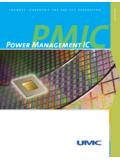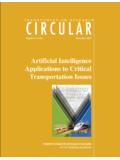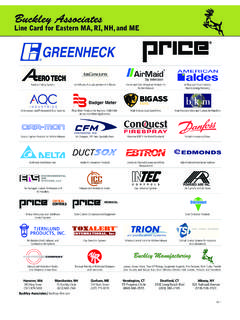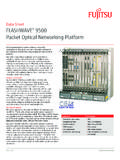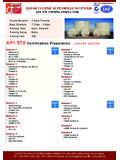Transcription of 40 - UMC
1 Nanometer 40 Nanometer UMC s volume production 40-nanometer technology supports today s high performance and low power requirements. Many customers have engaged with UMC for their 40nm projects, with multiple designs in various stages of production. UMC's 40nm utilizes advanced processes such as immersion lithography, ultra shallow junction, mobility enhancement techniques and ultra low-k dielectrics for maximum power and performance optimization. UMC's 40nm process consists of a low power platform (LP) focusing on the low power and low leakage design requirements for mobile and consumer applications, and a generic platform (G) that is optimized for a broad range of consumer and high-speed applications. Designers also benefit from comprehensive device offerings that include features to help optimize power and performance, different I/O voltage choices and analog/RF design resources. Lower operating voltage down to ultra low leaage device Integrated flows for logic, Mixed-Signal/RF Shallow trench isolation Retrograde twin well (Triple well option) Immersion Lithography implemented by NA= Mini-second anneal technology for ultra shallow junction Poly gate & S/D with NiSi process Advanced mobility enhancement techniques (Channel orientation, SMT, DSL, eSiGe) Up to 1P11M copper metal layers with ULK (k= ) 6T/8T SRAM bit cell option e-Fuse option BOAC (Bonding Over Active Circuit) Wire Bond/Flip Chip optionTechnology to Meet Broad Applications 40nm Key FeaturesGeneric (G) Low Power (LP)UMC 40nm TechnologyPortable Wireless ConsumerGraphics NetworkUltra Low Power (ULP)Wireless connectivity IOTI/O Devices Core Devices MS Devices Native I/O (OD.)
2 UD )MOMNCAPR esistorsG_LVt ( )G_RVt ( )G_HVt ( )LP_uLVt / 8V LDMOS40nm Logic/MS/RF TechnologyLP_LVt ( ) ( ) ( ) ( ) ( )RF Passive DeviceMOMV aractorResistorsInductorTransformer40nm Logic/MS/RF DevicesUMC offers comprehensive design resources that enable our customers to fully realize the advantages of UMC's advanced technologies. UMC's fundamental IPs (standard cells, I/Os, and memory compilers) help customers easily migrate their designs to the next process generation to realize significant performance advantages while also reducing die size. UMC has collaborated with RF IP company to offer competitive can also leverage application specific IPs that are specialized for all types of mainstream applications such as digital TVs, cellular baseband controllers, graphics, and networking Bluetooth, WiFI, GPS application to overcome time-to-market DDR,USB, LVDS, PLL, Embedded Memory PLL, USB, L VDS, Embedded Memory, HDMI, DDRnMobile DDR, USB, PCI-e, SATA, Embedded MemoryDDRn, PCI-e,HDMI, LVDS, Embedded MemoryDTVB asebandNetworkingGraphicComprehensive IP PortfolioG: Generic Platform LP: Low Power : RF model available.
3 Other models available upon customer requestFundamental IP Support Process Node40nm LP40nm uLPStandard Cell LibraryeLV T- LV T RVT HVT eHVT- I/O eFuse32b ~ 4Kb Single Port SRAM Compiler Dual Port SRAM Compiler -Single Port Register File Dual Port Register File -ROM Compiler Interface/Functional IP SupportFundamental IPs (standard cells, I/Os, and memory compilers listed below) are optimized to UMC technologies, and are planned for development from several leading vendors to be available free-of-charge (please contact a UMC account manager for more information). Customers can also leverage application specific IPs for DTV, graphics, networking, etc. IPs available through UMC are DFM (Design for Manufacturing) compliant for better LP40nm uLPUSB PHYS ynopsys USB PCIEGen IISynopsys SATA36 GSynopsys DDR multi PHYDDR2, 3, 3L, mDDR, LPDDR2 PHY(1066)Synopsys DDR 3/21600 MHzSynopsys TX & HEACS ynopsys MIPI D PHYTX & RXSynopsys PLLI nput frequency range:25~66 MHz,Output frequency range:200~400 MHzFTC PLLI nput frequency range:20~200 MHz,Output frequency range:500~ 1000 MHzFTC OTP8Kb~4 MbKilopass *For more information, please contact your account today's proliferation of low power applications, lowering energy consumption without sacrificing performance has become a critical concern for designers of power management chips for portable electronics.
4 UMC supports its standard cell library with low power design features, including multiple Vt, clock-gating, level shifter and other features to complement UMC s complete low power Power Features of Standard Cell LibraryTypeSupport PowerVoltage Island & ScalingLevel Shifters w / InsulatorPower & Timing Model @ 80% of Vdd Clock Gating & Frequency ScalingClock Gated F/F Leakage PowerMulti-VtMulti-Vt cells Power GatingIsolation cells, Retention F/FHeaders / Footers, etc. Body BiasTapless cellsTiming / Power Model Low Power Design SupportVoltage and frequency scalingLow leakage processBody bias20%20%40%40%60%60%80%80%Leakage Power SavingDynamic Power SavingClockgatingFront-end designBack-end designPower gatingMulti VthLow powersynthesisMulti VDDUMC Reference Design Flow UMC Reference Design Flow provides a design methodology and f low validated with a Leon2 system demonstration board. The f low incorporates 3rd-party EDA vendors baseline design f lows to address issues such as timing closure, signal integrity, leakage power and design for manufacturability and adopts a hierarchical design approach built upon silicon validated process libraries.
5 UMC Reference Design Flow covers from RTL coding all the way to GDS-II generation and supports Cadence, Magma, Mentor and Synopsys EDA tools. All of these tools can be interchanged for added f Definition/Spec & Tech-dependent SettingRTL Coding & SimulationPhysical VerificationLogic Synthesis Block & Top ImplementationStatic Timing Analysis & Gate-level SimulationFloorplan & PartitionTape-outI/O & MemorySimulation ViewTiming ViewTiming Constraint &DFT RequirementsDRC/LVSRule DeckPhysical & Noise ViewCell Function, Area, Timing & Power ViewFeatures of Design FlowCadenceSynopsysMentorFunctional Logic SimulationSchematic Entry-Logic Synthesis-Static Timing Analysis-Timing Closure-Signal Integrity-Floor Planning-Physical Synthesis-Multi-Vt Low Power-Multi-Vdd Low Power-Design For TestDesign For DiagnosisDFM - double via insertionDFM - dummy metal fillingCircuits SimulationPower Analysis-Layout EditorPlace & Route-Physical VerificationFormal Verification-Parasitic ExtractionNoise Analysis-Note.
6 AvailableReference Design Flow and Vendor SupportUMC works with leading EDA tool companies to provide a verified Reference Design Flow program to ensure the accuracy of customer designs in a proven environment. UMC s Reference Design Flow program integrates solutions for digital designs and low power solutions that incorporate the latest DFM resources available from leading third-party providers. Tools can be interchanged for added f offers optimal DFM (Design For Manufacturability) solutions to effectively and efficiently address factors that may negatively affect yield and performance for advanced technology designs. UMC s DFM solutions include advanced process models incorporated in SPICE and extraction decks for predicting random and systematic variations, technology files, DFM-compliant libraries and IP that embrace the intricacies of the fabrication process. Concise DFM recommendation rules are available along with a comprehensive rule-deck runset strategy to fulfill various design requirements.
7 UMC also offers pre-tapeout Optical Proximity Correction (OPC) and Litho Rule Check (LRC) for custom designs in addition to our standard post-tapeout services that include OPC, Litho Simulation Check (LSC), dummy fill, and metal slotting. At 65nm and below, UMC offers a DFM Design DFM Methodology RoadmapDFM RulesModeling with WEEM onte Carlo ModelsModeling with LOD & WPEM odeling with CMP EffectsCritical Area AnalysisStatistical Timing AnalysisRestricted RulesLitho Simulation ChecksEnablement Kit (DEK) to seamlessly support model-based DFM tools. The DEK has a built-in Graphic User Interface (GUI) for DFM design database setup, and is completed with application notes and qualification reports for design e-Fuse FeaturesTo reduce chip area, achieve better reliability performance, and shorten repair time compared to conventional Al fuse, UMC has developed an e-fuse solution to target the needs of a broad range of applications. The fuse array and complete functional macro are offered to ease the integration process for customers.
8 Both wafer level and package level fuse are supported. Moreover, customers can use e-fuse for the OTP (one time programming) function to save overall costs. No extra masks necessary Only one extra pad required Fuse array, programming circuit, sensing amplifier Serial and parallel architecture Allows metal routing over fuses (M6 and above) Programmable at package levelLogic Compatible Complete Functional IP MacrosDesign-Friendly Features Wafer level fuse options Package level fuse optionsFlexibilityVirtual Inductor LibraryUMC has worked with its EDA tool partners to deliver the industry's first parameterized inductor design kit based on full-wave simulation: the Virtual Inductor Library (VIL). The VIL enables RFCMOS designers to create and simulate custom inductor geometries that are compatible with UMC's processes. It is built upon UMC's Electromagnetic Design Methodology (EMDM), which allows engineers to easily and accurately create any RF structure. EMDM gives designers the flexibility to innovate new geometries simply by editing parameters such as diameter, number of turns or w/o center tapDifferential with center tapStackThe GUI based VIL can be used to simulate all types of RF Capacitor LibraryUMC and its EDA tool partners have delivered the industry's first parameterized MOM capacitor design kit based on full-wave simulation: the Virtual Capacitor Library (VCL).
9 The VCL enables RFCMOS designers to create and simulate custom capacitor geometries that are compatible with UMC's processes. It is built upon UMC's Electromagnetic Design Methodology (EMDM), which allows engineers to easily and accurately create any RF structure. EMDM gives designers the flexibility to innovate new geometries simply by editing parameters such as number of metal and fingers, arrays, and length of fingers for GUI based VCL can be used to simulate all types of RF Transformer Library UMC has also worked with its EDA tool partners to deliver the industry's first parameterized transformer design kit based on full-wave simulation: the Virtual Transformer Library (VTL). The VTL enables RFCMOS designers to create and simulate custom transformer geometries that are compatible with UMC's processes. It is built upon UMC's Electromagnetic Design Methodology (EMDM), which allows engineers to easily and accurately create any RF structure.
10 EMDM gives designers the flexibility to innovate new geometries simply by editing parameters such as primary impedance, secondary impedance, number of turns, mode, and frequency for GUI based VTL can be used to simulate all types of RF Design Flow and FDKThe FDK (Foundry Design Kit) provides IC designers with an automatic design environment. The methodology provides access to circuit-level design and simulation, circuit layout, and layout verification with accurate RF device models. In the front-end, fundamental components of UMC's MS/ RF process are implemented in common design environments and simulation tools. The back-end includes parameterized cells (P Cell), which include a schematic driven layout to provide an automatic and complete design flow. Callback functions are also provided in the design flow to minimize data entry. EDA tools for MS/RF designs are also supported. Schematic (Composer)(Symbols & CDF)Virtual Inductor/Capacitor/Transformer LibraryCadenceSpectre / Spectre RFSpectre / Spectre RFSimulation with VerifiedRF/Mixed Signal ModelsVirtual Inductor/Capacitor/Transformer Inductor/Capacitor/Transformer LibraryTape OutCircuit LayoutVirtuoso(P-cell)Verification & Extraction(DRC/LVS/LPE)Calibre/XRCA ssuraSchematicDriven LayoutArtistSpectre / Spectre RF Input: single/differential end Output: single/differential end Turn Ratio: 1:n, n:2n, n:nOptimum Inductor Finder (OIF)UMC offers the Optimum Inductor Finder (OIF) in the FDK package.

